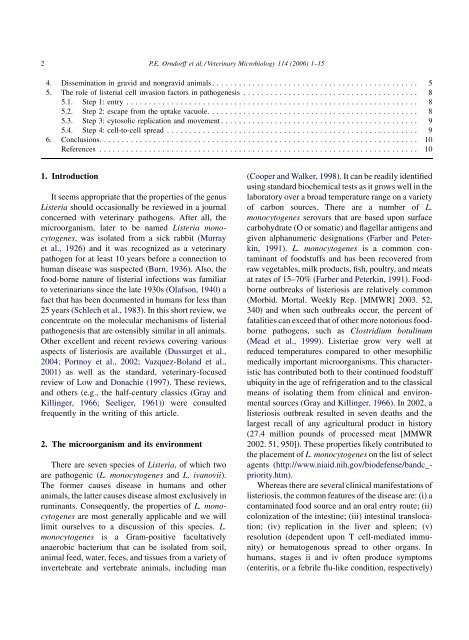Host and bacterial factors in listeriosis pathogenesis - University of ...
Host and bacterial factors in listeriosis pathogenesis - University of ...
Host and bacterial factors in listeriosis pathogenesis - University of ...
You also want an ePaper? Increase the reach of your titles
YUMPU automatically turns print PDFs into web optimized ePapers that Google loves.
2<br />
P.E. Orndorff et al. / Veter<strong>in</strong>ary Microbiology 114 (2006) 1–15<br />
4. Dissem<strong>in</strong>ation <strong>in</strong> gravid <strong>and</strong> nongravid animals. ............................................. 5<br />
5. The role <strong>of</strong> listerial cell <strong>in</strong>vasion <strong>factors</strong> <strong>in</strong> <strong>pathogenesis</strong> . ...................................... 8<br />
5.1. Step 1: entry . . ............................................................... 8<br />
5.2. Step 2: escape from the uptake vacuole. .............................................. 8<br />
5.3. Step 3: cytosolic replication <strong>and</strong> movement . . .......................................... 9<br />
5.4. Step 4: cell-to-cell spread . . ...................................................... 9<br />
6. Conclusions. ...................................................................... 10<br />
References ....................................................................... 10<br />
1. Introduction<br />
It seems appropriate that the properties <strong>of</strong> the genus<br />
Listeria should occasionally be reviewed <strong>in</strong> a journal<br />
concerned with veter<strong>in</strong>ary pathogens. After all, the<br />
microorganism, later to be named Listeria monocytogenes,<br />
was isolated from a sick rabbit (Murray<br />
et al., 1926) <strong>and</strong> it was recognized as a veter<strong>in</strong>ary<br />
pathogen for at least 10 years before a connection to<br />
human disease was suspected (Burn, 1936). Also, the<br />
food-borne nature <strong>of</strong> listerial <strong>in</strong>fections was familiar<br />
to veter<strong>in</strong>arians s<strong>in</strong>ce the late 1930s (Olafson, 1940)a<br />
fact that has been documented <strong>in</strong> humans for less than<br />
25 years (Schlech et al., 1983). In this short review, we<br />
concentrate on the molecular mechanisms <strong>of</strong> listerial<br />
<strong>pathogenesis</strong> that are ostensibly similar <strong>in</strong> all animals.<br />
Other excellent <strong>and</strong> recent reviews cover<strong>in</strong>g various<br />
aspects <strong>of</strong> <strong>listeriosis</strong> are available (Dussurget et al.,<br />
2004; Portnoy et al., 2002; Vazquez-Bol<strong>and</strong> et al.,<br />
2001) as well as the st<strong>and</strong>ard, veter<strong>in</strong>ary-focused<br />
review <strong>of</strong> Low <strong>and</strong> Donachie (1997). These reviews,<br />
<strong>and</strong> others (e.g., the half-century classics (Gray <strong>and</strong><br />
Kill<strong>in</strong>ger, 1966; Seeliger, 1961)) were consulted<br />
frequently <strong>in</strong> the writ<strong>in</strong>g <strong>of</strong> this article.<br />
2. The microorganism <strong>and</strong> its environment<br />
There are seven species <strong>of</strong> Listeria, <strong>of</strong> which two<br />
are pathogenic (L. monocytogenes <strong>and</strong> L. ivanovii).<br />
The former causes disease <strong>in</strong> humans <strong>and</strong> other<br />
animals, the latter causes disease almost exclusively <strong>in</strong><br />
rum<strong>in</strong>ants. Consequently, the properties <strong>of</strong> L. monocytogenes<br />
are most generally applicable <strong>and</strong> we will<br />
limit ourselves to a discussion <strong>of</strong> this species. L.<br />
monocytogenes is a Gram-positive facultatively<br />
anaerobic bacterium that can be isolated from soil,<br />
animal feed, water, feces, <strong>and</strong> tissues from a variety <strong>of</strong><br />
<strong>in</strong>vertebrate <strong>and</strong> vertebrate animals, <strong>in</strong>clud<strong>in</strong>g man<br />
(Cooper <strong>and</strong> Walker, 1998). It can be readily identified<br />
us<strong>in</strong>g st<strong>and</strong>ard biochemical tests as it grows well <strong>in</strong> the<br />
laboratory over a broad temperature range on a variety<br />
<strong>of</strong> carbon sources. There are a number <strong>of</strong> L.<br />
monocytogenes serovars that are based upon surface<br />
carbohydrate (O or somatic) <strong>and</strong> flagellar antigens <strong>and</strong><br />
given alphanumeric designations (Farber <strong>and</strong> Peterk<strong>in</strong>,<br />
1991). L. monocytogenes is a common contam<strong>in</strong>ant<br />
<strong>of</strong> foodstuffs <strong>and</strong> has been recovered from<br />
raw vegetables, milk products, fish, poultry, <strong>and</strong> meats<br />
at rates <strong>of</strong> 15–70% (Farber <strong>and</strong> Peterk<strong>in</strong>, 1991). Foodborne<br />
outbreaks <strong>of</strong> <strong>listeriosis</strong> are relatively common<br />
(Morbid. Mortal. Weekly Rep. [MMWR] 2003. 52,<br />
340) <strong>and</strong> when such outbreaks occur, the percent <strong>of</strong><br />
fatalities can exceed that <strong>of</strong> other more notorious foodborne<br />
pathogens, such as Clostridium botul<strong>in</strong>um<br />
(Mead et al., 1999). Listeriae grow very well at<br />
reduced temperatures compared to other mesophilic<br />
medically important microorganisms. This characteristic<br />
has contributed both to their cont<strong>in</strong>ued foodstuff<br />
ubiquity <strong>in</strong> the age <strong>of</strong> refrigeration <strong>and</strong> to the classical<br />
means <strong>of</strong> isolat<strong>in</strong>g them from cl<strong>in</strong>ical <strong>and</strong> environmental<br />
sources (Gray <strong>and</strong> Kill<strong>in</strong>ger, 1966). In 2002, a<br />
<strong>listeriosis</strong> outbreak resulted <strong>in</strong> seven deaths <strong>and</strong> the<br />
largest recall <strong>of</strong> any agricultural product <strong>in</strong> history<br />
(27.4 million pounds <strong>of</strong> processed meat [MMWR<br />
2002. 51, 950]). These properties likely contributed to<br />
the placement <strong>of</strong> L. monocytogenes on the list <strong>of</strong> select<br />
agents (http://www.niaid.nih.gov/biodefense/b<strong>and</strong>c_-<br />
priority.htm).<br />
Whereas there are several cl<strong>in</strong>ical manifestations <strong>of</strong><br />
<strong>listeriosis</strong>, the common features <strong>of</strong> the disease are: (i) a<br />
contam<strong>in</strong>ated food source <strong>and</strong> an oral entry route; (ii)<br />
colonization <strong>of</strong> the <strong>in</strong>test<strong>in</strong>e; (iii) <strong>in</strong>test<strong>in</strong>al translocation;<br />
(iv) replication <strong>in</strong> the liver <strong>and</strong> spleen; (v)<br />
resolution (dependent upon T cell-mediated immunity)<br />
or hematogenous spread to other organs. In<br />
humans, stages ii <strong>and</strong> iv <strong>of</strong>ten produce symptoms<br />
(enteritis, or a febrile flu-like condition, respectively)

















